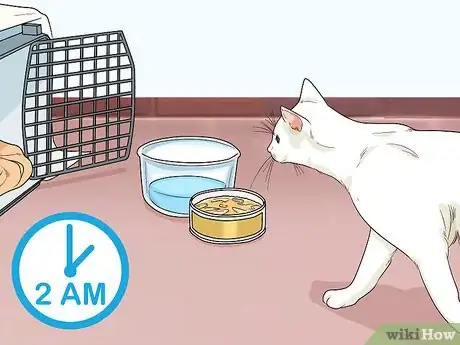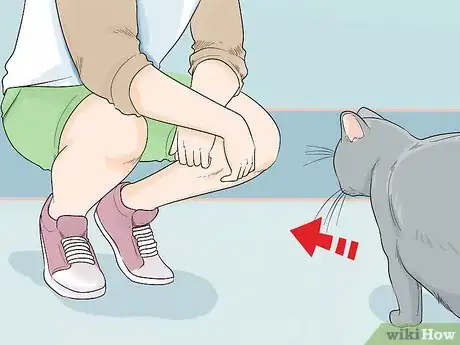This article was co-authored by Molly DeVoss and by wikiHow staff writer, Hunter Rising. Molly DeVoss is a Certified Feline Training and Behavior Specialist (CFTBS), a Certified Cat Behavior Consultant (CCBC), a Fear Free Certified Trainer (FFCT), and the Founder of Cat Behavior Solutions. Molly specializes in using positive reinforcement to modify and prevent unwanted behaviors in cats and reduce cat shelter surrender. Molly has sat on the Dallas Animal Advisory committee since 2013 and was voted one of the Top 12 Extraordinary Cat Behaviorists of 2020 by Catpetclub.com. She is certified by both the Animal Behavior Institute and the International Association of Animal Behavior Consultants. She is also the host of the weekly podcast Cat Talk Radio.
There are 10 references cited in this article, which can be found at the bottom of the page.
This article has been viewed 67,327 times.
New cats may be shy or scared of you when you first interact with them. Luckily, there are easy ways to make a cat come closer and trust you. Whether you're trying to attract cats outside or build trust in an indoor cat, with a little patience and dedication, you can make any reluctant cat come to you!
Steps
Luring Outdoor Cats
-
1Place a pet carrier or upside-down box outside. Use a small pet carrier for a cat that you already own, or use a cardboard box large enough for a cat to fit in. Flip the box upside down and use a pair of scissors or a utility knife to cut a 1 by 1 ft (30 by 30 cm) hole so a cat can fit inside.[1]
- Pet carriers can be purchased online or at your local pet store.
- If you use a pet carrier with openings on top, weight a blanket on top to make the enclosure dark.
-
2Line the bottom with soft bedding. Use a fleece blanket or a similar soft fabric on the bottom of the enclosure to make it more comfortable for the cat. Use extra fabric so the cat is able to cover itself without pulling the bedding off of the floor.[2]Advertisement
-
3Sprinkle catnip inside the enclosure. Catnip is an herb that attracts cats and gives them a “high.”[3] [4] Pinch some catnip between your fingers and sprinkle it on the bedding. For added effect, spread a little bit around the outside of the enclosure so cats can smell it from a distance.[5]
- Catnip can be purchased at your local pet store or grown at home.
-
4Use a can of wet food or tuna. Cats can smell wet foods easier than they can smell dry foods.[6] Once the can is opened, set it on the ground the enclosure. A cat may come when it’s ready to eat.[7]
- Keep a few extra cans in your pantry so you always have food when you need it.
- Try different flavors of cat food to see what attracts the cat the most.
- Let the cat eat without handling it. If it is an unfamiliar cat, leave it completely alone while it’s feeding. Talk at a normal volume around the cat so it can get used to your voice and associate it with feeding and good behavior.[8]
-
5Watch for cats around 2 AM. Many cats are active while humans are asleep since they will be searching for food. Keep an eye on the enclosure to see if any cats come for the food or for a place to sleep.[9]
Making a Shy Cat Trust You
-
1Don’t make loud noises in the same room as a cat. Avoid using vacuums, loud toys, or even brooms in the same room as a cat. Turn the volume of your music or TV to a reasonable level so the cat can get used to the common sounds of your home. While everything may sound like a lower volume to us, they are very loud to a cat’s sensitive ears.[10]
- If you need to clean in the same room as a cat, just be mindful of the noises you’re making so you don’t frighten them.
-
2Allow the cat to come to you. Sit still as the cat approaches you so it has a chance to get used to your scent and know that you will not harm it. Give the cat a chance to get used to you without attempting to handle it.[11] [12]
- You can either stand, sit, or lay down as a cat approaches you, but be sure not to make any sudden movements.
-
3Speak in a calm voice. Talk at a normal volume and avoid using baby talk or a high-pitched voice while addressing your cat. Loud noises will spook the cat, so avoid yelling while you’re around it. As you speak to your cat more, it will start to have a sense of security around you.[13]
-
4Pet the cat slowly and watch its body language. Make slow and predictable movements so you don’t startle the cat. Start petting it on its back and slowly work towards scratching behind its ears. If your cat tenses up or raises its hair, stop petting it and let it calm down.[14]
-
5Give the cat treats after good behavior. As the cat gets used to you, give it a small treat as a reward. As it starts to grow closer to you, it will associate their good actions with one of their treats and continue to repeat them.[15]
- Keep treats near you to attract the cat and associate you as a safe person. Don’t pet it as it eats or you may startle it.
Getting Your Lost Cat Back Home
-
1Place your cat’s soiled litter outside. If you’re trying to get a lost cat back home, set the litter box just outside near your home. Your cat may smell it and come back since this is where it is comfortable doing their business.[16]
- Make sure the litter has been used so your cat can smell it. Fresh litter will not work as effectively.
- Place a T-shirt or clothes you’ve worn recently near the litter so your cat is attracted to your scent.
-
2Shake a container of treats to draw them closer. If the cat is trained or housebroken, it may recognize the sound of their treats. Jostle the container so it makes a noise and see if the cat comes closer.[17]
- Cats associate treats with good behavior if they’re trained well.
-
3Call the cat’s name. Use your regular voice when you say its name so you don’t startle it. Cats will recognize their owner’s voice and may come back when they hear you calling them.[18]
- Have a treat ready so if the cat comes to you, you can reward it for good behavior.
Community Q&A
-
QuestionI have a cat who's lonely because I am away all the time, but he doesn't like other pets or people. How do I get him to like another cat?
 Community AnswerThat can be tricky, but a feline companion could be a great cure to your cat's loneliness. There are some good methods in wikiHow article Introduce a New Cat to Other Cats.
Community AnswerThat can be tricky, but a feline companion could be a great cure to your cat's loneliness. There are some good methods in wikiHow article Introduce a New Cat to Other Cats. -
QuestionIf I see a cat from the window and want it to jump into my garden, how do I do it?
 Community AnswerPlace a treat for the cat. If you are a non-vegetarian, then you'd probably have some fish. Keep it on a steady ground, first making sure that there are no other animals nearby who eat fish. Don't make much noise, don't make any sudden movements, and don't try to pick it up instantly; let it come to you. If you are a vegetarian, a bowl of milk will do the trick, too.
Community AnswerPlace a treat for the cat. If you are a non-vegetarian, then you'd probably have some fish. Keep it on a steady ground, first making sure that there are no other animals nearby who eat fish. Don't make much noise, don't make any sudden movements, and don't try to pick it up instantly; let it come to you. If you are a vegetarian, a bowl of milk will do the trick, too. -
QuestionDo cats have rabies?
 Community AnswerSome cats have rabies, most do not. If it is a domestic cat that is someone's pet, it's probably received vaccinations to prevent rabies. If it is a stray or feral cat, there is not way to know. Don't try to approach random cats you do not know.
Community AnswerSome cats have rabies, most do not. If it is a domestic cat that is someone's pet, it's probably received vaccinations to prevent rabies. If it is a stray or feral cat, there is not way to know. Don't try to approach random cats you do not know.
Warnings
- Cats tend to be protective, nocturnal, fearful, and VERY clever. Don't be upset if it doesn't work the first time.⧼thumbs_response⧽
- Never give cats milk. Contrary to popular belief, most cats have allergies to dairy and milk of any kind can cause serious problems.⧼thumbs_response⧽
- Be careful around feral cats since they have had little or no interaction with humans. Don’t try to handle them right away since they may bite or scratch.⧼thumbs_response⧽
Things You’ll Need
Luring Outdoor Cats
- Pet carrier or cardboard box
- Soft blanket
- Catnip
- Wet cat food or tuna
Making a Shy Cat Trust You
- Treats
Getting Your Lost Cat Back Home
- Litter box
- Soiled litter
- Treats
References
- ↑ https://www.petmd.com/cat/care/guide-finding-lost-cat
- ↑ https://youtu.be/mjnGSTVO1Hw?t=1m36s
- ↑ Molly DeVoss. Certified Feline Training and Behavior Specialist & Certified Cat Behavior Consultant. Expert Interview. 28 June 2021.
- ↑ https://www.scientificamerican.com/article/experts-how-does-catnip-work-on-cats/
- ↑ https://youtu.be/mjnGSTVO1Hw?t=1m20s
- ↑ Molly DeVoss. Certified Feline Training and Behavior Specialist & Certified Cat Behavior Consultant. Expert Interview. 28 June 2021.
- ↑ https://youtu.be/mjnGSTVO1Hw?t=55s
- ↑ https://purrfectlove.net/how-to-earn-a-cats-trust/
- ↑ https://www.petmd.com/cat/care/guide-finding-lost-cat
- ↑ https://purrfectlove.net/how-to-earn-a-cats-trust/
- ↑ Molly DeVoss. Certified Feline Training and Behavior Specialist & Certified Cat Behavior Consultant. Expert Interview. 28 June 2021.
- ↑ https://purrfectlove.net/how-to-earn-a-cats-trust/
- ↑ https://purrfectlove.net/how-to-earn-a-cats-trust/
- ↑ https://www.petful.com/behaviors/cats-shy-around-people/
- ↑ https://purrfectlove.net/how-to-earn-a-cats-trust/
- ↑ https://www.petmd.com/cat/care/guide-finding-lost-cat
- ↑ https://www.petmd.com/cat/care/guide-finding-lost-cat
- ↑ http://www.adventurecats.org/backcountry-basics/teach-your-cat-to-come-when-called/
About This Article
Cats are sometimes reluctant to come to you, but luckily you can use several tricks to attract them. You can lure a cat by opening a can of wet cat food or tuna, which they can smell from further away than dry food. If you’re trying to encourage the cat to come closer to you, sit still as it approaches so it doesn’t see you as a threat. Talk to it in a soft voice so it stays calm. As it comes closer to you, pet it slowly on its back so you don’t startle it. When it gets used to you, offer it treats to build a bond with it. If you want to catch the cat, set up a pet carrier or cardboard box with a hole cut in the side. Line the enclosure with a blanket to encourage the cat to lie down. You can also sprinkle catnip inside the box, which attracts cats and gives them a natural high. For tips on how to get your lost cat to come back home, keep reading!



















-Step-11-Version-6.webp)



















































